#gungnir viking art
Text
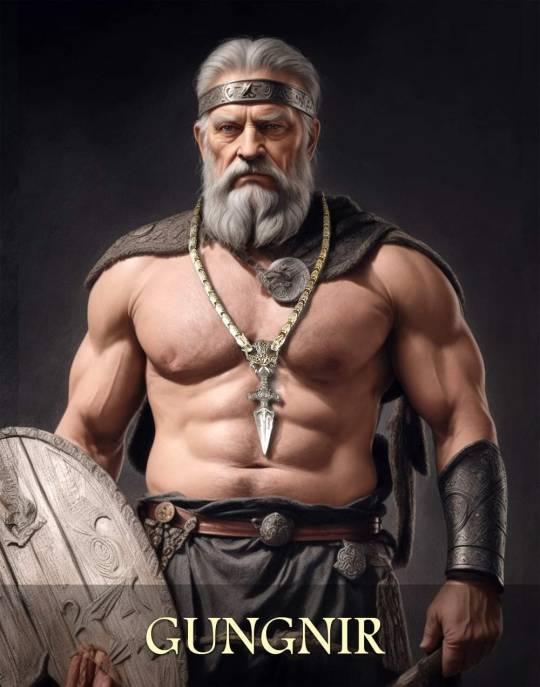
Source: MJOLNIR [Facebook]
7 notes
·
View notes
Text

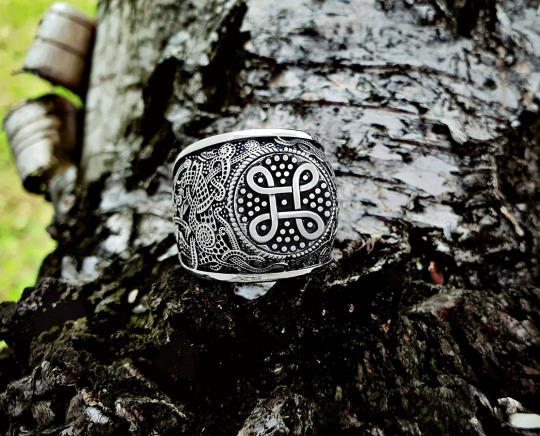
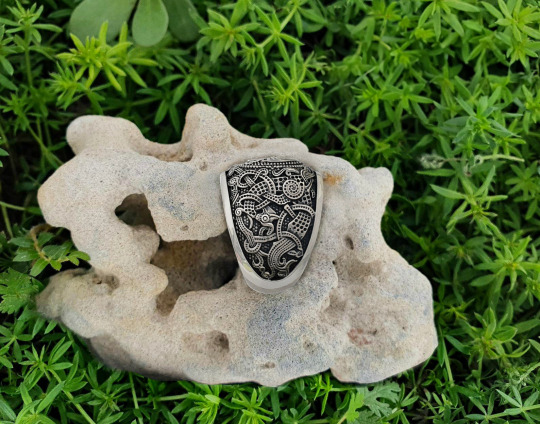
Viking shield knot ring - 99$
★Material: High Quality Solid 960 Sterling Silver★
Weight: approx. 17 g (0,59 oz)
Viking axe from Mammen.
In 1868 a farmer began to dig into the mound Bjerringhøj at Mammen near Viborg. During this work he chanced upon an unusually richly-furnished grave, which has become known as the grave from Mammen. A magnate was buried in the grave during the winter of 970-71 AD. He was given an expensive costume, a ceremonial axe with inlaid silver decoration and a large wax candle.
On one side a tree motif can be seen. It may symbolise the Christian Tree of Life or the pagan tree Yggdrasil. On the other side is an animal figure – perhaps the rooster Gullinkambi (Old Norse “golden comb”) or the Phoenix. According to Norse mythology Gullinkambi sits on top of the tree Yggdrasil. Here it wakes the Viking warriors every morning and it will crow at the beginning of Ragnarok (the end of the world).
In the rich mythological tapestry of the Norse pantheon, Odin emerges as a captivating and multifaceted deity, donning a myriad of roles and possessing a diverse array of attributes. While commonly revered as the god of war and death, his dominion extends far beyond the battleground. Ascending to the lofty heights of the celestial realm, he assumes the mantle of a sky god, presiding over the vast expanse above. From this exalted position, he radiates an aura of wisdom and inspiration, earning his distinction as the patron of poetry and the embodiment of sagacity.
Magic, an integral part of the mystical fabric woven within Norse mythology, finds its ultimate expression through Odin. Enigmatic and arcane forces course through his being, endowing him with an unparalleled understanding of the esoteric arts. His name resounds as the epitome of sorcery and enchantment, intertwining with the very essence of the supernatural.
Perched upon the magnificent Sleipnir, a wondrous and unparalleled eight-legged equine companion, Odin traverses the realms, transcending boundaries and connecting disparate worlds. With each stride, his indomitable presence ripples through the fabric of existence, leaving an indelible mark on the cosmic tapestry.
Gungnir, the renowned spear of Odin, stands as a testament to his martial prowess and unyielding resolve. Forged with meticulous precision by master craftsmen, this legendary weapon strikes true, unerringly finding its mark amidst the chaos of battle. Its gleaming edge serves as a symbol of the god's unwavering determination and unassailable power.
#vikingjewelry#exclusivejewelry#likeaviking#vikingstyle#norse#vikingring#ring#Shieldrring#Shield#handmade#silverwork#silverring#Odin#Mammen#mammenstyle#silverjewelry#vikings#handmadejewelry#VikingRing#ShieldKnotRing#NorseJewelry#VikingStyle#VikingFashion#NorseCulture#HandcraftedRing#VikingArt#AncientSymbol#ShieldKnot#NorseDesign#VikingAccessories
0 notes
Text
Check out this item in my Etsy shop https://www.etsy.com/se-en/listing/209201188/odin-figurine-by-titibaka

#odin statue#wodan#wotan#oden#gungnir#asatru#hearhen#germanic paganism#norse art#viking art#norse gods#norse mythology#norse#norsereligion#figurine#bronze figurines#figurines#titibaka
29 notes
·
View notes
Photo

"Mask of Ódin" - commissioned tattoo design. Main beard motif is inspired by the Danish runic inscription 66 known as the Mask stone, which was found in Aarhus, Denmark. I just remade it in the Ringerike style and I've attached the tip of the Odin's spear - Gungnir to the bottom of the beard and a helmet on the uppper part. I've also put an Aegishjalmur sign on the helmet as a customer's wish. Unfortunatelly he changed his mind about this design, so it's available for tattooing if you are interested 😉 #odin #mask #beard #fullbeard #helmet #oneeyed #god #godmask #denmark #history #mythology #fantasy #aegishjalmur #spear #gungnir #viking #norse #pagan #tattoo #tattoodesign #czech #art #linework #knotwork #dotwork #stippling #blackandwhite #red #ink (v místě Jablonec nad Nisou)
#mythology#odin#history#helmet#aegishjalmur#dotwork#godmask#spear#tattoodesign#linework#knotwork#blackandwhite#beard#fantasy#stippling#viking#gungnir#god#ink#art#mask#pagan#oneeyed#denmark#red#fullbeard#tattoo#norse#czech
90 notes
·
View notes
Note
Hey there Bedlam, I have one question: do you have any references of how Loki's hairstyle looks on Yonder Hill, I have zero imagination xD sorry! If you have, can you send me one? my chat is open if you happend to find a pic :D thanks and also a reference for Mistilteinn (i have a good day learning that it means Mistletoe and that it was some Legendary sword from a saga) :D
He shuffles through a couple of different hairstyles! I think I said at some point somewhere that I was looking at a lot of Lagertha's hairstyles from the History Channel's Vikings, as well as the other women from the show -- those kinds of faux-historical braids that you see in a lot of historical and high fantasy films/TV. (I want to say we first start seeing them show up in genre films/TV with LotR and the elves there, but they could have shown up earlier and I just don't remember.) (We do see them on characters in Asgard (and Thor has braids in his hair, I think from TDW onwards, so, like, I didn't do this completely out of nowhere. ) None of his hairstyles are based on anything specific (well, when his hair is just noted as plaited back it's in a single French braid), just sort of a vague compilation of various hairstyles.
(I'll put the next bit under a cut because it's a lot of reference images!)


which are not far off Natasha's braids in Black Widow, either. (I think at one point I was going to put in a crack about them both coming down to breakfast with the same hair, but I forgot to actually write it, lol.)

as well as looking at some of the dwarves' simpler hairstyles from The Hobbit films


Mistilteinn in design is based on the scepter/spear Loki gets at the end of the Agent of Asgard comics, though it's not exactly the same -- I think of the blade as being more sharply curved, and it's for sure an actual serious killing weapon. It's probably also decorated with that kind of Norse-esque knotwork we see on Mjolnir and throughout Asgard. It's essentially the Asgardian equivalent of the scepter from The Avengers. (No gem, obviously.) It's forged of uru, like Mjolnir, and was originally commissioned by Odin from Eitri as a gift for Loki (to give him after Thor's coronation), and when the events of Thor happened it ended up just staying at the Nidavellir forge until Loki turned up there following Thanos's rampage on the Statesman, where Eitri gave it to him. (Unlike Thor in Infinity War, Loki doesn't restart the forge star.)
Mistilteinn's not directly based on anything from the comics or elsewhere in Marvel -- the name is a nod to a sword from the sagas as well as the story of the mythological Loki making a spear out of mistletoe to kill Baldur with, but it's not supposed to be filling any of the roles of the mythological Mistilteinn. I wanted it to have a mythological hook, though! And since Laevateinn is already in both the comics and the MCU as a sword, it couldn't be Laevateinn; I definitely wanted Loki to have a polearm in Yonder, because (a) cool, (b) it mirrors Loki's weapons of choice in Thor (Gungnir) and The Avengers (the scepter), (c) I was kind of tired of Loki just being knife guy because knives are cool and all but I am very contrary (and I've got a sword Loki in another story), and (d) since he's functioning as King of Asgard throughout this story, it's a more dramatic weapon that gives him more weight and majesty. I also really loved the mental image of his arrival in Wakanda (which Natasha mentions in Chapter 1) being very, very similar to his arrival in The Avengers, so Mistilteinn takes the place of the scepter for that.
In terms of real world weapons and how it looks and how Loki fights with it, I was also thinking about Japanese naginata.
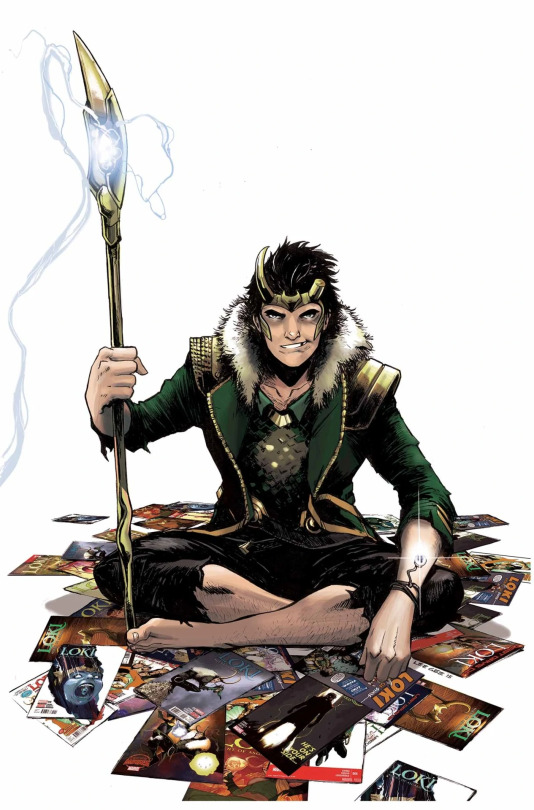
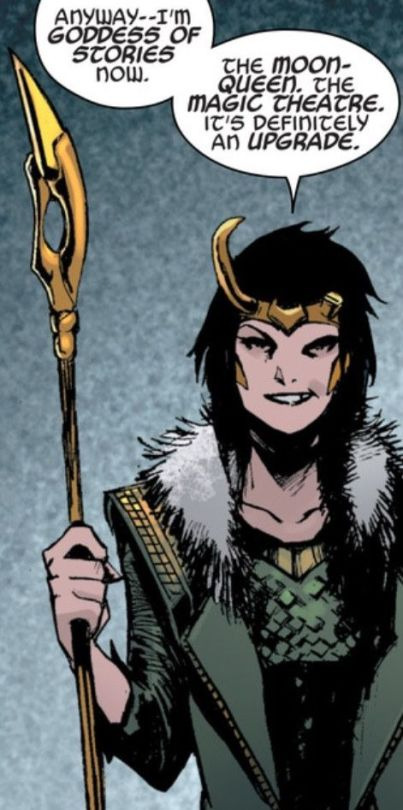
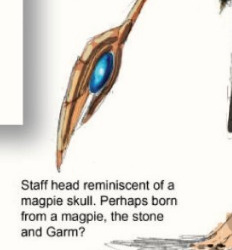
There was also some Thor Ragnarok concept art for possible Loki looks that had polearm weapons in them -- these are both by Aleksi Bricolet. (Also this one, but doesn't have a really good look at the polearm.)
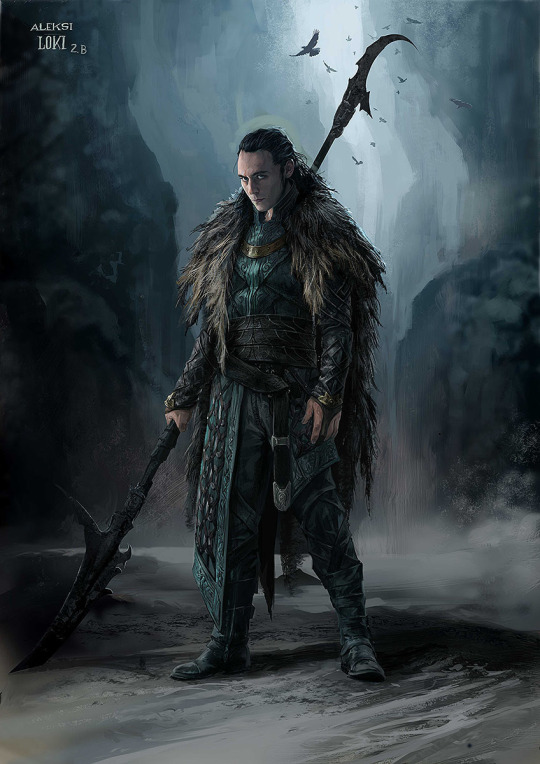
(source)

(source)
hopefully that helps!
23 notes
·
View notes
Text
Jerome Backstory
Circe ranks as one of the greatest witches of mythology. A beautiful enchantress . Circe, in Greek legend, a sorceress, the daughter of Helios, the sun god, and of the ocean nymph Perse. She was able by means of drugs and incantations to change humans into wolves, lions, and swine. The Greek hero Odysseus visited her island, Aeaea, with his companions, whom she changed into swine.
The daughter of Helios and Perse, Circe was a powerful enchantress versatile in the arts of herbs and potions and capable of turning human beings into animals. She did just that to Odysseus’ sailors when they reached her dwelling place, the secluded island of Aeaea. Odysseus, however, managed to trick her with the help of Hermes and, instead of becoming an animal, he became her lover for a year. The couple had three children, one of whom, Telegonus, eventually killed Odysseus.
Family
Circe was the daughter of Perse, one of the Oceanids, and Helios, the Titan sun god. As such, she was part of a family of formidable sorceresses. Pasiphae, who supposedly charmed both Minos and Procris, was her sister, and the even more notorious enchantress Medea was her niece, since she was the daughter of Circe’s brother Aeetes, the guardian of the Golden Fleece. Circe had another brother, Perses, who was slain by Medea after he had deposed her father Aeetes from the throne of Colchis.
Reaching Circe’s Island
Disheartened and dispirited from their horrendous encounter with the man-eating Laestrygonians – after which they had been left with only one out of their twelve ships – Odysseus and his remaining men land on Aeaea, Circe’s island.
At first glance, it seems to them like a desolate island, since the only visible sign of life is a column of smoke rising from somewhere deep in the woods. Naturally, Odysseus sends his men to investigate, putting his brother-in-law Eurylochus in charge of the scouting party.
The Transformation of Odysseus’ Men
After some time, the men reach Circe’s house and are surprised to find many fearsome beasts – mostly lions and wolves – slouching around and acting as domesticated as the tamest pets imaginable. From the inside, they hear a woman’s voice: it’s Circe singing melodiously.
Eurylochus suspects danger, so he chooses to stay outside as Circe comes out of her house and welcomes the rest of the scouting party indoors. Odysseus’ men are treated with some fine-flavored wine they gulp down in a second with the utmost pleasure. However, once they do that, Circe makes a quick move with her wand and, suddenly, all of Odysseus’ men are transformed into pigs. They still have their human brains, so they start grunting and weeping as Circe puts them into her pigsty.
Odysseus Tricks Circe
Eurylochus runs back to Odysseus and tells him the whole story and Odysseus decides to confront Circe. Fortunately, on his way to Circe’s house, he is met by Hermes, who gives him a magical black-rooted white-flowered plant called moly which, the divine messenger says, will make Odysseus immune to Circe’s spells.
As indicated by Hermes, Circe’s wine has no effect on the cunning Greek hero and so, after the enchantress pulls out her wand, Odysseus responds by pulling out his sword. He makes Circe swear that she won’t hurt him and forces her to restore the original form of all his sailors. Circe does precisely that and, furthermore, taken aback by his bravery, offers Odysseus her sincere love and unconditional devotion.
Odysseus accepts them, and, as a result, his men stay in Aeaea for almost a year, after which Odysseus becomes restless to go back to Ithaca and once again see his mortal wife, Penelope.
Odysseus’ and Circe’s Offspring
If we are to believe Hesiod’s genealogies, however, we must deduce that Odysseus returned to Aeaea once or twice more after this, or at least that he stayed there for a little longer than a year. Since Circe – says Hesiod – bore him no less than three children: Agrius, Latinus, and Telegonus. The last and youngest one of the three ended up killing Odysseus by mistake using a poisoned spear given to him by his mother.
Circe in Other Myths
Circe plays a smaller part in few other myths: she purifies Jason and Medea from a murder, and she transforms PIcus and Scylla into a woodpecker and monster respectively.
Jason and Medea
Circe shows up in the second most famous Ancient Greek story of sea adventures, the voyage of the Argonauts. According to Apollonius, after Jason and Medea treacherously and brutally kill the Colchian prince Absyrtus, it is Circe who purifies them from the sin, though she also chases them away from her island once she learns the full gravity of their transgression.
Circe, a Vengeful Lover
Before falling for Odysseus, Circe felt an attraction to at least three other men, the first one a mortal, and the second two a god.
The mortal was Picus, who was too faithful to his wife Canens for his own sake: after fiercely rejecting Circe’s advances, Picus was turned into a woodpecker. Unable to fight through the unbearable sorrow, six days later, Canens threw herself into the river Tiber.
Another time, the sea-god Glaucus asked Circe for a potion which would make the beautiful nymph Scylla fall in love with him. Circe, however, loved Glaucus for herself, so, when he scorned her, she gave him a potion which turned Scylla into the hideous sailor-preying monster Odysseus and his crew had to evade soon after leaving Circe’s island. The third was the God Odin. Odin was known for taking more than one female. Though he loved his mate, Odin had an affair with Circe keeping her happy so nothing bad fell on him.
Who was Circe?
The daughter of Helios and Perse, Circe was a powerful enchantress versatile in the arts of herbs and potions and capable of turning human beings into animals. She did just that to Odysseus’ sailors when they reached her dwelling place, the secluded island of Aeaea.
Where did Circe live?
Circe's home was Aeaea.
Who were the parents of Circe?
The parent of Circe was Helios.
Who were brothers and sisters of Circe?
Circe had 3 siblings: Pasiphae, Aeetes and Perses.
How many children did Circe have?
Circe had 4 children: Agrius, Latinus, Telegonus and Jerome.
Father: Odin
Odin (/ˈoʊdɪn/;[1] from Old Norse: Óðinn, IPA: [ˈoːðinː]) is a widely revered god in Germanic mythology. Norse mythology, the source of most surviving information about him, associates Odin with wisdom, healing, death, royalty, the gallows, knowledge, war, battle, victory, sorcery, poetry, frenzy, and the runic alphabet, and projects him as the husband of the goddess Frigg. In wider Germanic mythology and paganism, the god was known in Old English and Old Saxon as Wōden, in Old Dutch as Wuodan, and in Old High German as Wuotan, all ultimately stemming from the Proto-Germanic theonym *Wōđanaz, meaning 'lord of frenzy', or 'leader of the possessed'.
Odin appears as a prominent god throughout the recorded history of Northern Europe, from the Roman occupation of regions of Germania (from c. 2 BCE) through movement of peoples during the Migration Period (4th to 6th centuries CE) and the Viking Age (8th to 11th centuries CE). In the modern period the rural folklore of Germanic Europe continued to acknowledge Odin. References to him appear in place names throughout regions historically inhabited by the ancient Germanic peoples, and the day of the week Wednesday bears his name in many Germanic languages, including in English.
In Old English texts, Odin holds a particular place as a euhemerized ancestral figure among royalty, and he is frequently referred to as a founding figure among various other Germanic peoples, such as the Langobards. Forms of his name appear frequently throughout the Germanic record, though narratives regarding Odin are mainly found in Old Norse works recorded in Iceland, primarily around the 13th century. These texts make up the bulk of modern understanding of Norse mythology.
Old Norse texts portray Odin as one-eyed and long-bearded, frequently wielding a spear named Gungnir and wearing a cloak and a broad hat. He is often accompanied by his animal companions and familiars—the wolves Geri and Freki and the ravens Huginn and Muninn, who bring him information from all over Midgard—and rides the flying, eight-legged steed Sleipnir across the sky and into the underworld. Odin is the son of Bestla and Borr and has two brothers, Vili and Vé. Odin is attested as having many sons, most famously the gods Thor (with Jörð) and Baldr (with Frigg), and is known by hundreds of names. In these texts he frequently seeks greater knowledge, at times in disguise (most famously by obtaining the Mead of Poetry), makes wagers with his wife Frigg over the outcome of exploits, and takes part both in the creation of the world by way of slaying the primordial being Ymir and in giving the gift of life to the first two humans Ask and Embla. Odin has a particular association with Yule, and he provides mankind with knowledge of both the runes and poetry, giving Odin aspects of the culture hero.
Odin is a frequent subject of interest in Germanic studies, and scholars have advanced numerous theories regarding his development. Some of these focus on Odin's particular relation to other figures; for example, the fact that Freyja's husband Óðr appears to be something of an etymological doublet of the god, whereas Odin's wife Frigg is in many ways similar to Freyja, and that Odin has a particular relation to the figure of Loki. Other approaches focus on Odin's place in the historical record, a frequent question being whether the figure of Odin derives from Proto-Indo-European mythology, or whether he developed later in Germanic society. In the modern period the figure of Odin has inspired numerous works of poetry, music, and other cultural expressions. He is venerated in most forms of the new religious movement Heathenry, together with other gods venerated by the ancient Germani Odin, also called Wodan, Woden, or Wotan, one of the principal gods in Norse mythology. His exact nature and role, however, are difficult to determine because of the complex picture of him given by the wealth of archaeological and literary sources. The Roman historian Tacitus stated that the Teutons worshiped Mercury; and because dies Mercurii (“Mercury’s day”) was identified with Wednesday (“Woden’s day”), there is little doubt that the god Woden (the earlier form of Odin) was meant. Though Woden was worshiped preeminently, there is not sufficient evidence of his cult to show whether it was practiced by all the Teutonic tribes or to enable conclusions to be drawn about the nature of the god. Later literary sources, however, indicate that at the end of the pre-Christian period Odin was the principal god in Scandinavia.
From earliest times Odin was a war god, and he appeared in heroic literature as the protector of heroes; fallen warriors joined him in Valhalla. The wolf and the raven were dedicated to him. His magical horse, Sleipnir, had eight legs, teeth inscribed with runes, and the ability to gallop through the air and over the sea. Odin was the great magician among the gods and was associated with runes. He was also the god of poets. In outward appearance he was a tall, old man, with flowing beard and only one eye (the other he gave in exchange for wisdom). He was usually depicted wearing a cloak and a wide-brimmed hat and carrying a spear.
JEROME
As everyone knows, what Circe wanted, Circe got. When she set her sights on The father of Gods, Odin nothing would stop her. Odin, the God seen a beautiful God who could help him win his battles with her potions. Little did he know she would trick him, and keep him at her island for months while the plan all along was to impregnate her with a son. One she would cherish above all. He would be a brother to Thor. Only his powers would be that of not onky strength, he was a sorcerer as well. Jerome is out going, the life of the party. He has many abilities and ones he is still finding he has. He isn't like Father, or his Mother and is actually a nice guy with a huge heart. Yiu fuck with what's his, or family and he will make you pay.

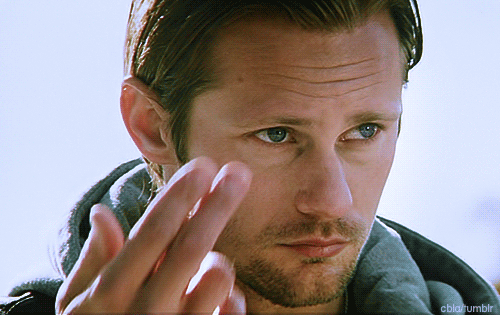
18 notes
·
View notes
Text

GUNGNIR
Gungnir (Old Norse Gungnir, “Swaying;” pronounced “GUNG-neer”) is the name of the mighty spear that belongs to the god Odin.
In the recorded Norse myths, Gungnir is the weapon most consistently and powerfully associated with Odin. Both poetry and visual art demonstrate that this connection is deep and long-standing. It goes back at least as far as the ninth century, when the poet Bragi Boddason referred to Odin as Gungnis váfaðr (“Gungnir’s shaker”). Pre-Christian Scandinavian visual art often depicts Odin bearing a spear; in fact, the spear is one of his most typical iconographic attributes. Such depictions are found from Viking Age runestones all the way back to Bronze Age rock carvings of a spear god, who very well may be Odin (though due to the very early date and lack of other distinguishing features, it’s impossible to say for certain).
As you’d expect for the weapon of a god, Gungnir is no ordinary spear. It was created by the dwarves, the most skilled smiths in the cosmos, as is related in the tale of how the gods’ greatest treasures were made. Gungnir is said to have runes carved on its point, which presumably increase its aim and deadliness through magic. Archaeology confirms that the Norse and other Germanic peoples did in fact carve runes into some of their spears; perhaps this was done in imitation of the mythical model of Gungnir.
#gungnir#odin#woden#norse paganism#norse mythology#old norse#norse pantheon#norse deities#norse pagan#pagan#germanic religion#norse religion
44 notes
·
View notes
Photo

It’s Odin’s Day, or Wodan’s Day! The name Wednesday is derived from Old English Wōdnesdæg and Middle English Wednesdei, "day of Woden", reflecting the pre-Christian religion practiced by the Anglo-Saxons, a variation of the Norse god Odin. - My artwork shown here depicts Odin riding his eight legged horse, Sleipnir into Valhalla carrying his magical spear, Gungnir. - Prints, apparel and MORE can be found at celtichammerclub.threadless.com ➖ #celtichammerclub #odin #wodan #wotan #wednesday #allfather #norse #nordic #viking #vikings #vikingtattoo #knotwork #sleipnir #odal #heathen #asatru #mythology #thor #ragnar #ivar #art #valhalla #asgard #norsemythology #history #legend #warrior #humpday #originalart #procreate https://www.instagram.com/p/CB0ijPGHIH2/?igshid=gihnjr3eff5o
#celtichammerclub#odin#wodan#wotan#wednesday#allfather#norse#nordic#viking#vikings#vikingtattoo#knotwork#sleipnir#odal#heathen#asatru#mythology#thor#ragnar#ivar#art#valhalla#asgard#norsemythology#history#legend#warrior#humpday#originalart#procreate
13 notes
·
View notes
Text
A Pantser writes a Book 1. - F for Impulse control

(Work in progress cover, the background art is by Klaus Pillon)
"Asgeir survived the Serpent's rise. He heard the thundering sound of Gjallarhorn, he saw the moon and starts devoured by wolves of the night, yet somehow he kept on living among the broken remains of what was once the kingdom of Midgard.
Scavenging weapons for those who still wish to fight, Asgeir is almost killed in a chance encounter and the only thing saving him is a perculiar spear etched with runes and harboring some great power - Gungnir, the spear of the Allfather himself. Together with a cursed halfbreed and a malicious witch, the young warrior sets out to use Gungnir's power against the Nameless God and the new rulers of Aesgard, taking revenge for the devastation Ragnarök caused."
Hey there, travelers!
First of all, I should apologize for the thinning number of posts here. I assure you this is not a trend, we'll catch up with ourselves, but there's a couple of things going on right now. First, school started again, so I'm back to uni learning about diseases and horrible things. Second, we sent SotS to a professional editor (Hurray!), and while we have a draft 1.5 of the sequel (I'll keep its name a mystery for now), we have yet to recieve beta feedback on that, so we're kind of in the eye of the storm considering writing.
BUT! What can be better to do in such a stituation than start another WIP? Nothing, that can. Absolutely nothing. The story of this WIP is rather interesting, so I thought I'd make it a series within a series, because it's sooo pantser it's almost a charicature.
"A Pantser Writes a Book" is that exact series. It's about my Wednesdays (my day-off mid week) where I'll write as much as I can stomach about an entirely new WIP and comment on exactly how the ideas came to mind. What I hope is for this to be as chaotic and interesting as possible, so fellow pantsers can relate, while plotters get a glimpse into how our mind works. Ready? Let's go then!
One day (to be precise, the day before yesterday) I was walking home, reading news on my phone and somehow my mind kept throwing Nanowar (of Steel)'s Valhalleluja at me like a really persistent youtube ad. If you haven't heard it, here's a link, just so you know the context. The crutch lines were "Hear our prayer philantropic Odin / Viking-friendly, slayer of the giants." That set me onto a really norse-mythology centered train of thought that after a few steps formed into a story idea.
What if a mortal uses Odin's spear, Gungnir to slay giants? That was the core idea, to which a lot of questions instantly arose.
First, why would Odin let go of his spear? Well, how about if he's not alive because Ragnarök happened? What if it's a nordic inspired post-apocalyptic world where the land is slowly sinking under the sea like it's said in the Edda, everything is filled with the remains of battle between the gods, the warriors of Valhalla and the jötnar invaders?
Let's say our MC is a young norse warrior who tries to make a living during the apocalypse scavenging usable weapons and selling them for food in the few shelters where humanity holed up. And by sheer chance, he happens upon the place where Fenrir devoured Odin, and finds his spear.
That sounded so good I already had the first scene in my head, so when I arrived home, I sat down and started writing. I wrote around 900 words in an hour, then another 600 or so today, ending up with 1,5k for an intro sequence. More than that, my impulse control lacked so badly I ended up creating a spaceholder cover for it, and I even put it up to Wattpad.
If you're interested in the end result, here's a link to it: https://www.wattpad.com/story/241168064-after-the-gods
Before you cry "crucify him", this is not a promo for my Wattpad account (that would be really shitty). This is just commentary about the process and I find it much more practical to show you the end result this way (also, I feel way more safe with Wattpad's copyright stuff so I can freely throw this at you without having to go the extra mile).
So, don't hesitate to tell me what you think about the story, about this whole idea, about my writing style, whatever comes to your mind. I'll try to keep the series semi-spoilery, so I'll only comment things you can read in that week's segment. Go read it if you'd like, then come back and read my overly energetic chipmunk styled notes.
See you next week, travelers!
Cheers,
Dar
0 notes
Photo

Él es representado como un hombre de mediana edad con un pelo plateado, largo rizado y con una extensa barba. Su arma, llamada Gungnir, era un tridente que le hicieron los enanos. Estaba frecuentemente acompañado de los dos cuervos llamados Hugin y Munin (que significan, cada uno, "Pensamiento" y "Memoria")... . . . Info: mitología.fandom.com Arte:@grimorioabertobr #culturavikinga #vikingculture #nordicculture #odin #thor #loki #viking #vikings #nordic #norway #mljönir #mljonir #valhalla #aesir #nordicgods #fenrir #hela #wolf #hugin #munin #god #dios #raven #nordicart #vikingart (en Asgard) https://www.instagram.com/p/CAz0A9NHJyn/?igshid=fecl999e1h7f
#culturavikinga#vikingculture#nordicculture#odin#thor#loki#viking#vikings#nordic#norway#mljönir#mljonir#valhalla#aesir#nordicgods#fenrir#hela#wolf#hugin#munin#god#dios#raven#nordicart#vikingart
0 notes
Photo

GUNGNIR
Manu (aka. Skiold)
Source
#gungnir#odin's spear#gungnir art#odin's spear art#rune#runes#elder futhark#rune art#norse mythology#norse myths#norse mythology art#norse myths art#norse gods#Viking gods#norse paganism#norse god
10 notes
·
View notes
Photo

It’s Odin’s Day, or Wodan’s Day! The name Wednesday is derived from Old English Wōdnesdæg and Middle English Wednesdei, "day of Woden", reflecting the pre-Christian religion practiced by the Anglo-Saxons, a variation of the Norse god Odin. - My artwork shown here depicts Odin riding his eight legged horse, Sleipnir into Valhalla carrying his magical spear, Gungnir. - Prints, apparel and MORE can be found at celtichammerclub.com ➖ #celtichammerclub #odin #wodan #wotan #wednesday #allfather #norse #nordic #viking #vikings #vikingtattoo #knotwork #sleipnir #odal #heathen #asatru #mythology #thor #ragnar #ivar #art #valhalla #asgard #norsemythology #history #legend #warrior #humpday #originalart #procreate https://www.instagram.com/p/BwWlKObHqDB/?utm_source=ig_tumblr_share&igshid=8e7e3gjl1b4a
#celtichammerclub#odin#wodan#wotan#wednesday#allfather#norse#nordic#viking#vikings#vikingtattoo#knotwork#sleipnir#odal#heathen#asatru#mythology#thor#ragnar#ivar#art#valhalla#asgard#norsemythology#history#legend#warrior#humpday#originalart#procreate
27 notes
·
View notes
Photo

“Odin the Wanderer riding Sleipnir.” Completes piece for a commission. ➖ #celtichammerclub #commission #commissionwork #norse #nordic #norseart #vikingart #viking #mythology #norsemythology #nordic #nordicart #odin #wotan #god #gods #oldways #heathen #vector #illustrator #art #artwork #originalart #rune #runes #wolf #wolves #ravens #gungnir #sleipnir
#rune#oldways#artwork#ravens#wolf#originalart#vector#vikingart#norseart#norse#mythology#runes#god#celtichammerclub#illustrator#gungnir#sleipnir#nordicart#gods#wotan#commission#viking#art#nordic#heathen#wolves#norsemythology#odin#commissionwork
12 notes
·
View notes
Photo

Él es representado como un hombre de mediana edad con un pelo plateado, largo rizado y con una extensa barba. Su arma, llamada Gungnir, era un tridente que le hicieron los enanos. Estaba frecuentemente acompañado de los dos cuervos llamados Hugin y Munin (que significan, cada uno, "Pensamiento" y "Memoria")... . . . Info: mitología.fandom.com Arte:@grimorioabertobr #culturavikinga #vikingculture #nordicculture #odin #thor #loki #viking #vikings #nordic #norway #mljönir #mljonir #valhalla #aesir #nordicgods #fenrir #hela #wolf #hugin #munin #god #dios #raven #nordicart #vikingart (en Asgard) https://www.instagram.com/p/CAz0A9NHJyn/?igshid=2idm2fdn9beg
#culturavikinga#vikingculture#nordicculture#odin#thor#loki#viking#vikings#nordic#norway#mljönir#mljonir#valhalla#aesir#nordicgods#fenrir#hela#wolf#hugin#munin#god#dios#raven#nordicart#vikingart
1 note
·
View note